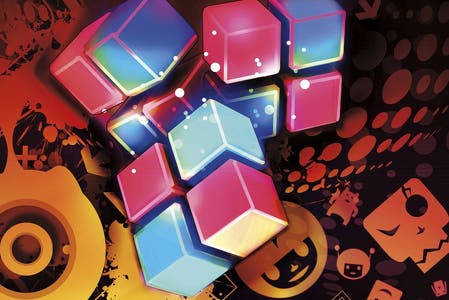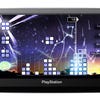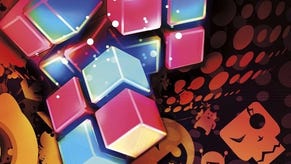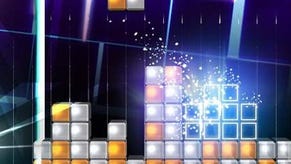Lumines: Electronic Symphony Review
Everybody's shufflin'.
For two games that are forever being lumped together, there's plenty of mechanical variation separating Tetris and Lumines. The former's purely about spatial sense, for starters, while the latter piles rhythmic elements and colour-matching on top.
One of the biggest differences, however, is actually structural. Ask any falling-block fan and they'll tell you that Tetris is a sprint while Lumines is a marathon. By the time you're any good at Q Entertainment's stylish puzzler, you're going to be able to play it for hours at a time off the back of a single life.
That's probably where the skins came from. Lumines' ever-changing audiovisual backdrops offer a smart way of keeping things fresh, while also allowing the game's developers the opportunity to alter the pace of the drops and the speed of the sweeping timeline. It gives players something new to think about every few minutes while they stoically sort blocks and arrange colours - and skins have also been a bit of a boon when it comes to sequels. With a game that puts music and art design right at the heart of the experience, providing a handful of new sights and sounds has meant that Q can release a series of entirely agreeable follow-ups without ever having to risk ruining everything by tampering with the crucial elements of the concept.
So when you try to work out what's new for Electronic Symphony, Lumines' first appearance on the Vita, the new skins are the most obvious starting point. Visually, they light up the unit's lavish 5" screen like nothing else - and when it comes to track choices, they're amongst the best the series has seen to date, too.
Standouts? Like your favourite songs on an album (apologies, I'm getting on a bit and I still think in the music industry's equivalent of old money) these tend to change every few hours. For the time being, though, I'm a huge fan of Played-A-Live, by Safri Duo - I hate the drums, but I love the giant angry robot who's constantly taking on helicopters - and Traces of the Past, by Makoto Asai, which is like the old Palace Video logo brought to life as a wonderfully creepy Halloween-'em-up filled with leering pumpkins and pointy spires.
There are very few duds overall, in fact, and if the musical line-up is a little more Eurocentric than usual, it also manages to be more harmoniously varied. Each transition fundamentally changes the pace and the atmosphere, but there seems to be some kind of mysterious internal logic to the flow of the main campaign, too. Music games often turn into a grim contemporary hits compilation; Electronic Symphony feels more like a trip through a single person's record collection. (Ask your parents about records!)
Crucially, skins can now be unlocked through an XP system as well as through plugging away at Voyage mode. This means you'll still have to play the game for dozens of hours if you want to see everything, but those dozens of hours won't have to be part of a single, hand-crippling session. Nice idea, Q: my early-onset arthritis is entirely appreciative. XP's shared across all game types, and it also allows you to build up a collection of those dinky little Lumines avatars and pay for a UAV. That last bit isn't true.
Elsewhere, the biggest new feature is the shuffle block. It appears randomly and rearranges the layout of your stack - sometimes awkwardly, sometimes brilliantly - whenever it lands. It's a blunt agent of chaos, in other words, which means it operates rather beautifully alongside the good old chain block - the secret heart of Lumines - which requires a well-ordered playing field and a tidy mind in order to work its colour-cancelling magic.
(The chain block, incidentally, now behaves a little differently, as far as I can tell. Back in the day, I'm pretty sure that it could only be set off once it was part of a 4x4 set. Now it comes to life the moment it connects with any blocks of the same colour, regardless of whether you've built it into a square or not. This takes a little getting used to, and while it creates a much more dynamic game, it means it's harder to have a dormant chain lurking deep within the stack for a rainy day or a happy accident.)
Avatars now come with special powers - different ones for single-player and competitive games - that might see you forcing a chain onto the battlefield, or randomising an opponent's block rotation, say, while all of the squares you clear in any mode now go towards deleting a massive World Block. This looks like that big cube that everybody's always getting upset about in Transformers, and it regenerates every day, encouraging you to play as often as you can to get the shared XP bonus it offers.
Modes, meanwhile, are stripped back to the holy triumvirate of Voyage (the main campaign), Duel (local only), and Playlist, alongside Stopwatch, which provides a range of very short time-attacks, and Master, which sees you working your way through a series of brutally difficult stages. Beyond that, if you're looking for new-console gimmickry, you can play Lumines using only the touch-screen, swiping to move and tapping to rotate. Like thumb-stick control, it works fine, but it won't be tempting me away from the Vita's wonderfully clicky dpad and face buttons any time soon.
All told, Electronic Symphony is a pleasantly weird update, then. It offers warm familiarity, with a safe selection of modes and a reassuringly lovely pile of new skins, alongside tiny, precision bursts of innovation like the shuffle block. It's another incremental improvement - but, if you ask me, this has always been a game that Sony's handheld needs if it's to feel complete. Lumines will be wedged in the Vita's card slot for months to come - it's up to other developers to try to shift it.























